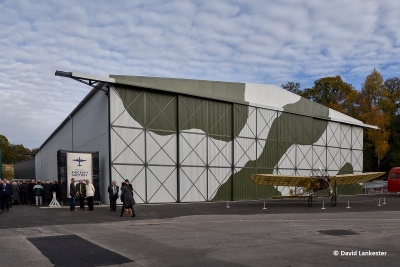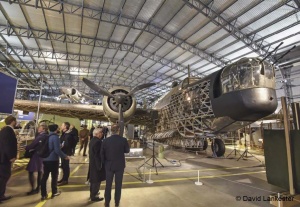Difference between revisions of "Brooklands Museum Aircraft Factory and Racetrack Revival"
(Created page with "==Structural Steel Design Awards 2018 - Commendation== {{#image_template:image=File:Brooklands_Museum-1.jpg|align=right|wrap=true|width=400}...") |
|||
| Line 4: | Line 4: | ||
The project also included the [[Construction|construction]] of a new Flight Shed building to house some of the Museum’s expanding aircraft collection, together with workshops and archive facilities. The hangar was re-clad with new profiled [[Building_envelopes|steel cladding]] that matched the original profile externally but incorporating [[Building_envelopes#Insulation|insulation]] to provide enhanced environmental conditions inside. As part of the project, a major new exhibition celebrating the history of aircraft manufacture was created within it. | The project also included the [[Construction|construction]] of a new Flight Shed building to house some of the Museum’s expanding aircraft collection, together with workshops and archive facilities. The hangar was re-clad with new profiled [[Building_envelopes|steel cladding]] that matched the original profile externally but incorporating [[Building_envelopes#Insulation|insulation]] to provide enhanced environmental conditions inside. As part of the project, a major new exhibition celebrating the history of aircraft manufacture was created within it. | ||
| + | {{#image_template:image=File:Brooklands_Museum-2.jpg|align=left|wrap=true|width=300}} | ||
| + | Analysis of the structure showed that there was a weakness in the [[Portal_frames#Haunch dimensions|haunch connection]], which could be overstressed in [[Design_codes_and_standards#Wind actions|high winds]] particularly when the hangar doors were open, creating a dominant opening. Low key strengthening works to the haunches were developed, which did not fundamentally affect the nature or appearance of the structure. The repairs are expressed through the use of different section profiles and colours to distinguish new from original elements. | ||
| − | |||
| − | |||
Careful dismantling was undertaken to avoid damaging the existing components of the building. The components were then individually tagged to define their location and orientation to make sure that all the components would fit back together again in the same locations. Once transported to the steelwork contractor’s factory, each element was [[Fabrication#Shot blasting|sand blasted]] to remove the many layers of old paint and reveal the extent of any damage or [[Corrosion_of_structural_steel|corrosion]]. Where major damage or corrosion was found, elements were repaired to match the original structure. The steelwork was then [[Paint_coatings#Application_of_paint_coatings|re-painted]] and carefully [[Fabrication#Handling and transportation|transported]] back to site for [[Construction#Steel erection|re-erection]]. | Careful dismantling was undertaken to avoid damaging the existing components of the building. The components were then individually tagged to define their location and orientation to make sure that all the components would fit back together again in the same locations. Once transported to the steelwork contractor’s factory, each element was [[Fabrication#Shot blasting|sand blasted]] to remove the many layers of old paint and reveal the extent of any damage or [[Corrosion_of_structural_steel|corrosion]]. Where major damage or corrosion was found, elements were repaired to match the original structure. The steelwork was then [[Paint_coatings#Application_of_paint_coatings|re-painted]] and carefully [[Fabrication#Handling and transportation|transported]] back to site for [[Construction#Steel erection|re-erection]]. | ||
Revision as of 12:39, 12 March 2019
Structural Steel Design Awards 2018 - Commendation
Brooklands is the birthplace of British motorsport and aviation, and the home of many remarkable engineering and technological achievements throughout the 20th Century. Over the past three years, Brooklands has seen another unique engineering achievement – the successful relocation and refurbishment of the 78-year-old, Grade II listed, Bellman Hangar to reinstate key surviving elements of the original motor racetrack.
The project also included the construction of a new Flight Shed building to house some of the Museum’s expanding aircraft collection, together with workshops and archive facilities. The hangar was re-clad with new profiled steel cladding that matched the original profile externally but incorporating insulation to provide enhanced environmental conditions inside. As part of the project, a major new exhibition celebrating the history of aircraft manufacture was created within it.
Analysis of the structure showed that there was a weakness in the haunch connection, which could be overstressed in high winds particularly when the hangar doors were open, creating a dominant opening. Low key strengthening works to the haunches were developed, which did not fundamentally affect the nature or appearance of the structure. The repairs are expressed through the use of different section profiles and colours to distinguish new from original elements.
Careful dismantling was undertaken to avoid damaging the existing components of the building. The components were then individually tagged to define their location and orientation to make sure that all the components would fit back together again in the same locations. Once transported to the steelwork contractor’s factory, each element was sand blasted to remove the many layers of old paint and reveal the extent of any damage or corrosion. Where major damage or corrosion was found, elements were repaired to match the original structure. The steelwork was then re-painted and carefully transported back to site for re-erection.
In addition to the re-erection of the hangar, a free-standing mezzanine was designed within the hangar to increase the exhibition space. This mezzanine also included a bridge across to the adjacent Flight Shed, linking the two buildings without the need for extensive alterations to the Bellman Hangar.
The project was successfully completed and opened in November 2017. It is a resounding testament to the flexibility and durability of steel design, both in its original concept and in how it can be sustainably and sympathetically adapted and re-used many years after its original design life has been exceeded.
| Architect | Thomas Ford & Partners |
| Structural Engineer | Alan Baxter Ltd |
| Steelwork Contractor | Ainscough Industrial |
| Main Contractor | Brymor Construction Ltd |
| Client | Brooklands Museum |
Judges' comment
This project is a testament to the adaptability of steel construction and the care with which the project team managed the task of dismantling the old hangar, refurbishing individual components and reassembling the structure on a nearby site, providing the ideal accommodation for the museum display.





